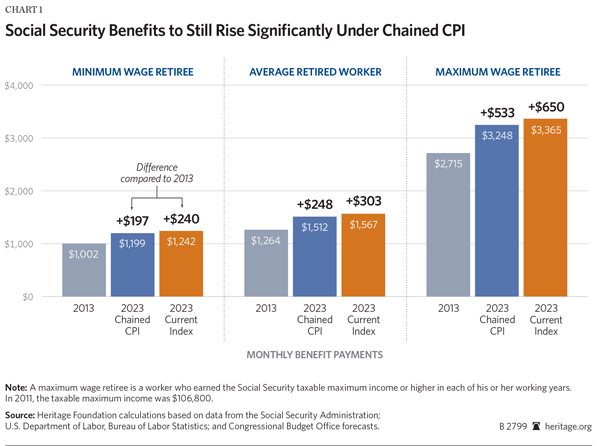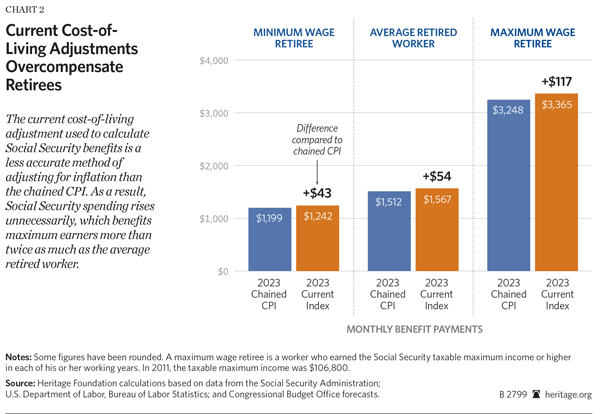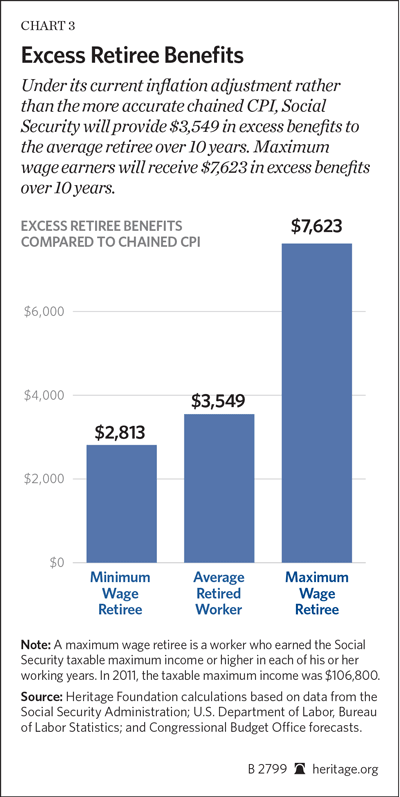More than 57 million Americans draw on Social Security benefits for retirement, disability, or survivors’ benefits. Social Security benefits are indexed for inflation to protect beneficiaries against the loss of purchasing power as the prices of goods and services rise over time. However, the index used to calculate Social Security’s cost-of-living adjustment (COLA) each year is outdated, inaccurate, and overstates the rise in the cost of living. Adopting the chained Consumer Price Index (CPI),[1] a more accurate measure, would stave off automatic cuts in Social Security benefits for a few additional years while still protecting the benefits from inflation.
There is bipartisan agreement among many policymakers and economists that the chained CPI is a more accurate index for calculating changes in the cost of living from inflation,[2] but many seniors fear that adopting the chained CPI would cut their benefits and reduce their purchasing power. In reality, Social Security benefits would continue to rise with inflation under a chained CPI, and the COLAs would more accurately reflect changes in the cost of living than the current index does. This paper demonstrates how using the chained CPI would affect the average beneficiary, a retired minimum wage earner, and a retired worker with consistent maximum taxable earnings.
Chained CPI: A More Accurate Index
Indexing for inflation in federal benefit programs such as Social Security maintains the purchasing power of benefits over time. Without inflation indexing, inflation would erode the value of benefits as the prices of goods and services increase, allowing beneficiaries to buy less and less over time.
The first Social Security COLA went into effect in 1975, about 40 years after the program’s inception. Before then, increasing Social Security benefits required an act of Congress. Congress first recomputed benefits for inflation in 1950. This adjustment, combined with a subsequent one in 1952, nearly doubled the value of Social Security benefit checks for existing beneficiaries.[3] Inflation was relatively high at the time, and the automatic COLA that went into effect in 1975 had a 3 percent trigger mechanism: Unless the measured annual increase in the cost of living was 3 percent or more, there was no automatic increase in benefits. The trigger was repealed in 1986, allowing COLA increases for every year that the cost of living increases.[4]
Today, a more accurate index is available than when Social Security first implemented its cost-of-living adjustment. In 1975, the Bureau of Labor Statistics published only the Consumer Price Index, known now as the Consumer Price Index for Urban Wage Earners and Clerical Workers (CPI-W). It is based on prices paid by urban wage workers and clerical workers, who make up only 32 percent of the population. The broader Consumer Price Index for All Urban Consumers (CPI-U), from which the chained CPI is derived, covers 87 percent of the population. The CPI-W not only is outdated and covers only a small subset of the population, but also fails to account for how consumers respond to changing prices.
Goods and services included in the CPI-W and the CPI-U are based on the 2007 and 2008 Surveys of Consumer Expenditures, but most Americans are not buying the exact same things today that they did in 2007 and 2008.[5] As prices change, consumers shift their buying patterns to maximize their purchasing power. For example, if the price of corn doubles because of increased ethanol production, people will buy less corn and more alternative grains. By assuming that everyone buys the same amount of corn regardless of price, current inflation measures overstate the cost of living and allow beneficiaries of inflation-adjusted payments to purchase more quantity or quality each year than they did in the previous year.
Beginning in 1999, the Bureau of Labor Statistics began reporting a more accurate measure of inflation called the chained CPI. The chained CPI recognizes that people will buy more bananas and fewer oranges if the price of oranges doubles, and it adjusts the basket of goods it uses to calculate inflation accordingly. In contrast, the current measure would assume, at least in the near term, that people would purchase the same number of oranges even if the price quintupled. According to the nonpartisan Congressional Budget Office (CBO), the chained CPI “provides a more accurate estimate of changes in the cost of living from one month to the next.”[6]

COLAs with a Chained CPI
The chained CPI more accurately measures the cost of living by correcting existing flaws that allow inflation-adjusted benefits to rise in both absolute and relative purchasing power over time.
If the chained CPI replaces the current COLA measure, monthly Social Security checks over the next 10 years would still rise substantially. Minimum wage earners retiring in 2013 would see their monthly benefits rise by $197, today’s average retired worker would receive an additional $248 per month, and maximum wage earners retiring in 2013 would receive $533 more per month. Over the next 20 years, minimum wage retirees would see their monthly benefits rise by $466, the average Social Security retiree would receive an additional $588 per month, and maximum wage retirees would receive $1,262 more per month.
However, under the current COLA index, Social Security benefits will grow faster. Compared with a COLA based on the chained CPI, current benefit payments will give a minimum wage worker retiring in 2013 an additional $43 per month by 2023, the average retired worker an additional $54 per month, and a maximum wage earner an extra $117 per month. These benefits are in excess of what is needed to maintain beneficiaries’ purchasing power after inflation. By 2033, these excess benefits would rise to $98 per month for a minimum wage retiree, $124 per month for the average retired worker, and $266 per month for a maximum wage retiree.
Excess COLA increases from the current flawed index are contributing to Social Security’s long-term fiscal insolvency. Lawmakers could eliminate about one-fifth of Social Security’s long-term fiscal imbalance by implementing a chained-CPI COLA.[7] However, if lawmakers allow Social Security benefits to increase faster than the cost of living, the excess payments will result in earlier and deeper cuts for Social Security recipients, beginning in less than 20 years.[8]
Over the next 10 years, maintaining the current COLA adjustments will result in cumulative excess payments of $2,813 for today’s minimum wage retiree, $3,549 for the average retired worker, and $7,623 for today’s maximum wage retiree. Over 20 years, these excess payments rise to $11,427 for the minimum wage retiree, $14,415 for the average retired worker, and a whopping $30,962 for a maximum wage retiree.

Budget Implications
In recent testimony to the House Subcommittee on Social Security, the Congressional Budget Office called the chained CPI “an improved measure of overall inflation” and reported that adopting the chained CPI would save Social Security about $130 billion over 10 years. The Social Security Trustees estimated that the improved COLA would delay automatic benefit cuts by an additional three years while closing more than one-fifth of Social Security’s long-term shortfall.[9] While the chained CPI is an improved measure of the cost of living and should be adopted across all federal benefit programs, lawmakers should not use any of the projected savings to prop up other spending programs.[10]

President Obama’s fiscal year 2014 budget proposed implementing the chained CPI for Social Security’s COLA and for the tax code in 2015. Moving to chained CPI in the tax code would push taxpayers into higher tax brackets sooner, resulting in a $100 billion tax increase over nine years that would hit middle-class Americans. Changing the inflation measure in the tax code should be done only as part of tax reform to prevent the tax burden on American families from rising even further above what is already projected to exceed the historical average. The fiscal imbalance stems from unprecedentedly high government spending, not too little tax revenue. Consequently, any new tax revenue generated from a change to the chained CPI should be offset elsewhere in the tax code. It should not be used as a way to raise revenue, as the President proposes.[11]
The Experimental Elderly Index
Opponents of indexing Social Security to the chained CPI often call for using the experimental Consumer Price Index for the Elderly (CPI-E), an alternate index targeted toward the elderly population. This experimental index seeks to account for the different purchases that seniors make compared with the rest of the population. In the past, the CPI-E has risen faster than the current CPI measure because the elderly tend to purchase more health care, which typically experiences a higher rate of inflation. However, problems in measuring and applying the CPI-E would likely make a COLA based on the CPI-E even less accurate than the current COLA.[12]
First, one-third of Social Security beneficiaries are not elderly. Social Security also pays benefits to eligible disabled and survivors, including children. The cost-of-living changes for these beneficiaries may be closer to that of the overall population.
Second, the CPI-E includes persons age 62 and older, many of whom remain in the workforce for several more years before claiming Social Security benefits. It is not clear that the purchasing behavior of working seniors aligns more closely with the retired elderly.
Third, the sample size for the CPI-E is only one-quarter that of the CPI-U sample. Such a small sample size greatly increases the probability of sampling error, potentially reducing the measurement’s accuracy.
Finally, using a very specific index, such as the CPI-E, for Social Security or another large government program could prompt demands for a broad array of new inflation measures and COLA adjustments exclusive to specific population groups. Consumer purchases vary across all different types of sociodemographic categories, including age, income, family structure, and location.
For example, low-income households tend to spend a higher proportion of their incomes on food, housing, and energy. Households with young children spend more on diapers and day care, and individuals and families living in New York City pay more for housing than those living in rural Kansas. According to such reasoning, the government should begin measuring and providing a wide variety of indexes to measure inflation for different populations, such as a CPI-TANF for recipients of Temporary Assistance for Needy Families (TANF) and a CPI-SNAP-HCA for beneficiaries of the Supplemental Nutrition Assistance Program (SNAP or food stamps) who live in high-cost areas (HCA). Devising and implementing a collection of exclusive indexes would add complexity and costs and increase the potential for measurement errors.
In addition to discrepancies in measuring the cost of living, there are also purely preferential differences. High-income retirees living in Beverly Hills probably spend more of their income on clothing and beauty services than average-income retirees in Jackson, Mississippi. However, this does not mean that the government should subsidize those preferences by providing different Social Security COLAs for different groups of retirees.
Cost-of-living adjustments for federal benefits should instead seek to protect the value of safety net benefits from inflation in the most reasonable and cost-effective way. The chained CPI does just that.
A First Step Toward Social Security Reform
Many Americans rely solely on Social Security for income. However, the current program is unsustainable and threatens to impose drastic benefit cuts in less than 20 years. Adopting the chained CPI as a more accurate measure of the cost of living is a sound technical correction that would maintain beneficiaries’ purchasing power over time. Changing the inflation measure in the tax code should be done only as part of tax reform to avoid increasing the tax burden on American families so that any resulting tax increase is offset elsewhere in the tax code.
Adopting the chained CPI for Social Security COLAs would improve accuracy and be a small first step toward reforming Social Security. The Heritage Foundation’s Saving the American Dream plan lays out other necessary reforms that would save the Social Security safety net for current and future retirees by strengthening benefits for those with the greatest need.[13]
—Romina Boccia is Assistant Director of the Thomas A. Roe Institute for Economic Policy Studies and Rachel Greszler is Senior Policy Analyst in Economics and Entitlements in the Center for Data Analysis at The Heritage Foundation.
Analytical Appendix
Using data from the Bureau of Labor Statistics, we estimated annual COLAs based on the CPI-U and the CPI-W. We applied the Social Security Administration’s method for COLA calculations, which calculates the percent difference between the average price index in the third quarter of each year compared with the average for the third quarter of the prior year.[14] For example, the 2013 COLA would equal the percent change in the third quarter average inflation index from 2011 to 2012. The calculated COLAs for 2010–2012 differ from the actual COLAs due to negative CPI-W growth in 2010. In estimating Social Security benefits, we used the actual COLA adjustments for these years.
We estimated future COLAs based on the CPI-U and CPI-W using the Congressional Budget Office’s 2013 economic projections for annual inflation. Because COLA adjustments reflect the prior year’s inflation, we lagged these inflation estimates by a year, so that the CBO’s CPI-U inflation estimate for 2013 equals the CPI-U COLA for 2014.
Because the CPI-W differs from the CPI-U and the CBO does not provide CPI-W forecasts, we took the average differential between the CPI-U and CPI-W from 2001 to 2012 (0.048 percentage point) and added this to the CBO’s CPI-U projections to obtain projected CPI-W COLAs. This differential does not affect the resulting discrepancies between chained-CPI benefits and current benefits because this difference is held constant, per the CBO assumptions detailed below.
Chained CPI-U estimates were calculated by subtracting 0.3 percentage point from current CPI-W COLA adjustments. In a 2011 analysis of the effects of moving to a chained-CPI COLA, the Social Security Administration assumed that chained-CPI COLAs would average 0.3 percentage point lower than the current COLA base.[15] This differential represents a historical average, resulting in potentially larger discrepancies between the current COLA and a chained-CPI COLA. Former Director of the Office of Management and Budget Peter Orszag has argued that the discrepancy between the CPI and chained CPI has been declining and may continue to diminish over time.[16]
We estimated current Social Security benefits based on the Social Security Administration’s benefit calculations formula.[17] Because workers’ Average Indexed Monthly Earnings (AIME) are calculated at age 62, we applied the actual Social Security COLA adjustments for 2010–2013 as well as chained-CPI COLAs for comparison.
Future Social Security benefits were calculated using projections based on the current CPI-W COLA and a chained-CPI COLA. Estimates were calculated for a minimum wage earner retiring in 2013 (monthly benefit of $1,002 in 2013), the average Social Security retired worker in 2013 (monthly benefit of $1,264 in January 2013), and a maximum wage earner retiring in 2013 (monthly benefit of $2,715 in 2013).[18] We assumed that the minimum wage and maximum wage workers retiring in 2013 were born on December 31, 1946, began working in 1969 (at age 22), and retired on January 1, 2013, at the full retirement age of 66. We also assumed that the minimum wage retiree worked 2,000 hours per year at the prevailing federal minimum wage while the maximum wage retiree earned the Social Security taxable maximum wage or higher each year. In 2011, the Social Security taxable maximum was $106,800.
We compared annual, 10-year, and 20-year cumulative benefits under the different COLA calculations for the sample beneficiaries for 2013–2033.



